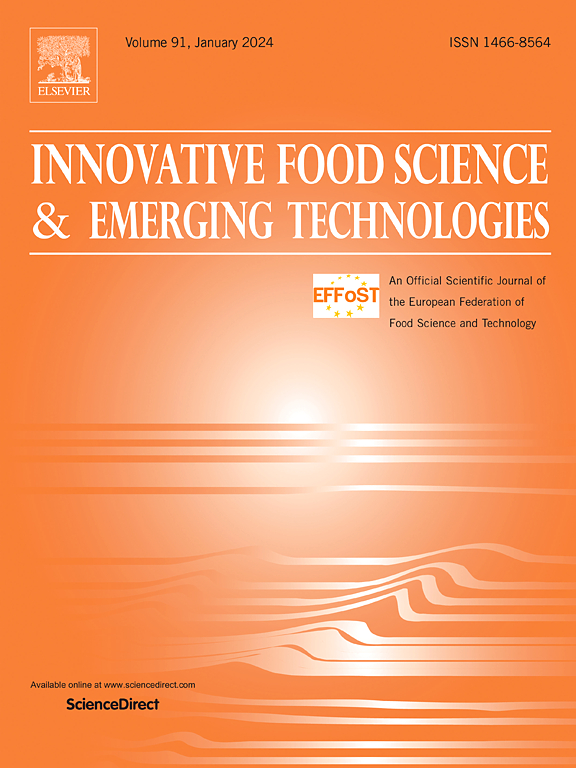Novel coaxial 3D printing for future foods: Multi-material structuring for functional and sustainable resource innovation
IF 6.8
1区 农林科学
Q1 FOOD SCIENCE & TECHNOLOGY
Innovative Food Science & Emerging Technologies
Pub Date : 2025-06-23
DOI:10.1016/j.ifset.2025.104087
引用次数: 0
Abstract
The advancement of future food production relies on technological innovation to optimize resource utilization. Recent research highlights the transformative potential of coaxial nozzle printing (CNP), a novel technique surpassing conventional single-nozzle printing (SNP) and dual-nozzle printing (DNP). By integrating multi-channel nozzles into a coaxial configuration, CNP enables the construction of “core-shell structures” for diversified ingredient recombination and synchronous deposition, offering new possibilities to meet consumer demands for functionally specialized and diversified future food products. This study systematically compares the technical distinctions among SNP, DNP, and CNP in nozzle design, material extrusion mechanisms, and precision-determining factors. The innovative applications of CNP in future food production are summarized and analyzed in detail, including the one-step integration of effective encapsulation, the innovative design of specialized dietary, also the sustainable production of meat analogues. Current challenges in the industrial implementation of CNP along with feasible solutions, have been identified to advance sustainable and functional-oriented future food innovation.
Industry relevance
The “core-shell structure” enabled by CNP offers multiple advantages for innovating functional and diversified future food processing: 1) Simultaneous multi-material deposition allows one-step integration encapsulation to realized functionalization or customization; 2) Cross-linking during printing facilitates texture modification and regulation; 3) Masking capabilities for undesirable flavors/colors enhance functional utilization of sustainable alternative ingredients. For scalable implementation, CNP's technical principles and printing determinants are systematically reported, its diverse applications in food manufacturing are summarized, and theoretical solutions for industrial-scale production are proposed.
新型同轴3D打印未来食品:多材料结构的功能和可持续的资源创新
未来粮食生产的进步依赖于技术创新来优化资源利用。最近的研究强调了同轴喷嘴打印(CNP)的变革潜力,这是一种超越传统单喷嘴打印(SNP)和双喷嘴打印(DNP)的新技术。通过将多通道喷嘴集成到同轴配置中,CNP能够构建“核壳结构”,用于多种成分的重组和同步沉积,为满足消费者对未来食品功能专业化和多样化的需求提供了新的可能性。本研究系统地比较了SNP、DNP和CNP在喷嘴设计、材料挤压机制和精度决定因素方面的技术差异。对CNP在未来食品生产中的创新应用进行了详细的总结和分析,包括有效封装的一步整合、专业化膳食的创新设计以及肉类类似物的可持续生产。目前CNP在工业实施中的挑战以及可行的解决方案,已经被确定为推进可持续和以功能为导向的未来食品创新。CNP支持的“核壳结构”为创新功能性和多元化的未来食品加工提供了多重优势:1)多材料同时沉积,一步集成封装,实现功能化或定制化;2)印刷时的交联有利于纹理的修饰和调节;3)掩盖不良味道/颜色的能力增强了可持续替代成分的功能利用。为了可扩展的实施,CNP的技术原理和印刷决定因素被系统地报道,其在食品制造中的各种应用进行了总结,并提出了工业规模生产的理论解决方案。
本文章由计算机程序翻译,如有差异,请以英文原文为准。
求助全文
约1分钟内获得全文
求助全文
来源期刊
CiteScore
12.00
自引率
6.10%
发文量
259
审稿时长
25 days
期刊介绍:
Innovative Food Science and Emerging Technologies (IFSET) aims to provide the highest quality original contributions and few, mainly upon invitation, reviews on and highly innovative developments in food science and emerging food process technologies. The significance of the results either for the science community or for industrial R&D groups must be specified. Papers submitted must be of highest scientific quality and only those advancing current scientific knowledge and understanding or with technical relevance will be considered.

 求助内容:
求助内容: 应助结果提醒方式:
应助结果提醒方式:


